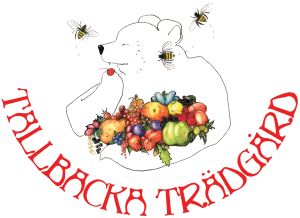

Tallbacka in 2023 - part 5
New vitality for berries and fruits
It has been 6 years since most of our berry bushes and fruit trees were planted. The exceptionally severe drought in 2018 and 2019 caused problems and in some cases certainly caused many of the difficulties we have encountered. They made us look for a solution to the problems and eventually change the cultivation method. The soil does not recover immediately and the plants may never fully recover, but what’s done is done; We also didn’t want to dig everything up and start all over again. The mistakes annoyed us, but that won’t help us to move on. I have previously written about mulching and the gooseberry sawfly. Cherry trees and sweet rowans died during the icy winter of 2021-2022. The raspberries no longer yielded a proper harvest so we decided to remove them. The currant bushes are plagued with the currant moth, which took a large part of the harvest and made the harvest labour intensive. We have harvested berries for our own use and filled our freezers, but only a fraction of the potential harvest, and the quality has not always been the best. Something must be done about the situation!
Michael Phillips “The Holistic Orchard”
When we were looking for methods to help the berry bushes and fruit trees that were already planted, we found the huge book of the American Michael Phillips about holistic orchard cultivation. The book is unique in terms of the amount of text but also in terms of its content. Phillips strives for naturalness and health in all areas; the health of the soil, the health of the grower and the functioning of the ecosystem as a whole. In addition to being large and beautiful, Phillips’ orchard apples are also superior in nutritional content. All measures, which he deals with in his garden, are aimed at the well-being of fruit trees, which means pests and diseases do not cause great damage. I must immediately clarify that the appearance of his garden does not correspond to the established ideals and the surroundings do not look like a golf course!
From the book we immediately applied some practical methods. When we remove the bush wood, we get wood chips, which are beneficial for fruit trees and berry bushes. As it decays, the soil in the garden is favoured by fungi and microorganisms. We compost the wood chips and also use them as covering material for the paths between the beds. We don’t cut the dandelion flowers because the pollinators need them. Around the fruit trees we plant comfrey, which is an excellent accelerator plant with its deep tap roots that produce a large mass of leaves during the season and release large amounts of minerals, as they decay, to the fruit trees. Comfrey has time to produce several leaf harvests and flowers during a season. We started to make a mixture of neem oil, EM microbes and algae powder and spray the solution onto the vegetation. Phillips also adds fish oil to the mixture, but we have not been able to find such oil in Finland. In 2023, we carried out the treatment twice, at the budding at the beginning of the season and at the beginning of flowering. Phillips does the treatment four times and closely follows the development of the tree. He is constantly aware of when the pests appear and develop and can limit the actions to the right time. He particularly emphasises the importance of thinning the apples before they ripen. We have a lot to learn! The main concerns are sawfly damage on berry bushes and fungal infestation on plums. We intend to continue and learn more and hopefully we will eventually get a better balance in the orchard. Our resources and time still do not allow for such accuracy as Phillips’ book instructs, but we do what we can.
New round of strawberries and raspberries
For the time being, we have no reason to be satisfied with our strawberry cultivation. The first attempt suffered from the drought and the associated manganese shortage and the well-cultivated soil caused problems with planting. The plants of the second experiment had probably been so badly damaged during transport that they never had the strength to grow properly. The winter killed most of the plants so we lost two seasons without a proper harvest, which was frustrating. When it came to the third attempt, we focused on the seedlings. They are micropropagated in Pargas and raised at Peuraniemi nursery, the varieties are Malwina and Lumotar. The first summer is over and the soil is getting better so we hope for the best.
In 2018, we made 35 meter long hügelbeds on both sides of the newer part of the garden. We grew pumpkins in them the first year and later cabbage, onions and carrots. The southern bed turned out to be too dry for vegetables and as we had removed the old rows of raspberries at the same time, we decided to plant new raspberries in the long bench. We thought of different varieties but chose the Glen Ample variety and some cherry bushes (Porthos, Athos) from Savonlinnan taimisto. In April 2023 we planted 60 raspberry plants and later in the summer we built supports as sturdy as was economically possible. During the autumn we spread old leaves and horse compost over the bed. Berry and fruit growing has been challenging and not easy for us. We didn’t put in as much effort as was required. Our knowledge and experience has not been enough. But we learn all the time. We hope that the measures we have taken will eventually lead to a good end result. So that the Tallbacka Bear on our logo gets its arms full!